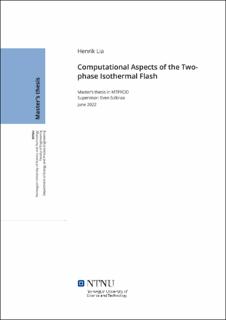| dc.contributor.advisor | Solbraa, Even. | |
| dc.contributor.author | Lia, Henrik. | |
| dc.date.accessioned | 2022-10-07T17:33:24Z | |
| dc.date.available | 2022-10-07T17:33:24Z | |
| dc.date.issued | 2022 | |
| dc.identifier | no.ntnu:inspera:112775046:37070240 | |
| dc.identifier.uri | https://hdl.handle.net/11250/3024767 | |
| dc.description.abstract | Helt siden introduksjonen av komposisjonell modellering med bruk av kubiske tilstandslikninger på 1950- og 1960-tallet, har den to-fase isotermiske flash-beregningen vært essensielt for å predikere faseoppførsel for petroleumsystemer og andre flerkomponent systemer. Metoder for å automatisere prosedyren og redusere tidsbruken, har vært viktig i å bidra til at komposisjonelle beregninger har blitt mulig å bruke i kommersielle sammenhenger.
Kubiske tilstandslikninger har vist seg å være nøyaktig og enkle nok til å bli brukt for å beskrive de fleste tradisjonelle petroleumsfluider. Teorien bak beregninger ved bruk av kubiske tilstandslikninger er veldokumentert i litteraturen, men de numeriske aspektene assosiert med å utføre matematikk med begrenset presisjon har ikke blitt like godt vektlagt.
Flash-beregningen er et komplekst system med likninger som er veldig sensitive til valget av initiale estimater og løsningstilnærminger. Det er mange strategier og tommelfingerregler i litteraturen som prøver å gjøre beregninger så robust som mulig, men som fortsatt gjør beregningene så fort som mulig. Målet ved denne oppgaven er (1) å sammenlikne forskjellige løsningsmetoder funnet i litteraturen, (2) beskrive en metode for hvordan å effektivt implementere de gitte metodene fra et beregningsperspektiv og (3) utvikle nye metoder hvor alvorlige avrundingsfeil skjer.
En ny, rask og robust algoritme for å beregne røttene til en kubisk tilstandslikning har blitt utviklet, som anvender tidligere beregnede røtter for å forbedre initialestimater. En ny algoritme er beskrevet, som bruker flyttallsmatematikk for å unngå alvorlige avrundingsfeil i beregninger av materialbalansen og garanterer at en numerisk nøyaktig løsning er funnet.
Flere metoder for å oppdatere K-verdiestimater har blitt sammenliknet i denne oppgaven. Metodene er delt inn i (1) akselererte suksessiv substutisjonsmetoder og (2) andreordens metoder. En sammenlikning mellom suksessiv substutisjonsmetoden, Wegsteins akselererte metode og to dominant egenverdibaserte metoder har blitt gjort. De viktigste punktene i sammenlikningen er beregningstid og konvergens til riktig løsning. En andreordens multivariabel Newton-Raphson metode har blitt implementert og sammenliknet med de akselererte suksessiv substutisjonsmetodene.
Når man utvikler ytelseskritiske beregningsprogrammer er det viktig å optimalisere de mest ytelseskritiske segmentene av programmet. En metode for å profilere og kvantifisere ytelse på et konsistent vis har blitt utviklet med dette som hovedprinsipp. | |
| dc.description.abstract | Ever since the introduction of compositional modeling using equations of state in the 1950s and 1960s, the two-phase isothermal flash calculation has been essential for predicting the phase behavior of petroleum and other multi-component systems.
Methods for automating the procedure and decreasing the amount of time have been essential in making compositional calculations feasible in a commercial setting.
The cubic equation of state model has proven to be both accurate and simple enough to be used to describe most traditional petroleum fluids.
The theory of cubic equation of state calculations has been well documented in the literature.
However, the numerical aspects associated with finite-precision mathematics in modern computers have not been emphasized to the same extent.
The flash calculation is a complex system of equations that are very sensitive to the choice of initial estimates and solution approaches.
There is a wide range of heuristics and \textit{rule of thumbs} in the literature that attempts to make the calculation as robust as possible, while still making the calculations as fast as possible.
The purpose of this thesis is to (1) compare different methodologies provided in the literature, (2) give a workflow of how to efficiently implement the given methodologies from a computational perspective, and (3) develop novel methodologies where severe numerical errors occur.
First a novel, fast, and robust algorithm for determining the roots of cubic equations of state was developed, that utilizes previously calculated roots to enhance the initial estimates.
Then a novel method is described that uses the theory of finite-precision mathematics to avoid severe round-off errors in the solution of the material balance, and guarantees that a numerically accurate solution is found.
A variety of methods for updating the estimated K-values have been compared in this thesis.
The methods are divided into (1) accelerated successive substitution methods, and (2) second-order methods.
A comparison was made between the standard successive substitution, the Wegstein accelerated method, and two dominant eigenvalue-based methods.
Key points of investigation in this work are computational speed and the ability of the different methods to converge to the correct solution.
A second-order multivariate Newton-Raphson method was investigated and compared to the accelerated successive substitution methods.
When developing performance code, the most important aspect is to improve the segments of the code that have the largest impact on performance.
A framework for profiling and quantifying performance in a consistent manner was developed using this as the guiding principle. | |
| dc.language | eng | |
| dc.publisher | NTNU | |
| dc.title | Computational Aspects of the Two-phase Isothermal Flash | |
| dc.type | Master thesis | |
